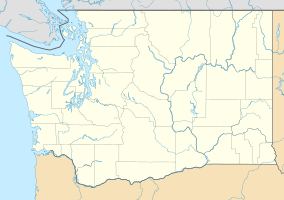Fort Casey facts for kids
Quick facts for kids Fort Casey Historical State Park |
|
|---|---|

Fort Casey disappearing gun
|
|
| Location | 1280 Engle Road, Coupeville, Washington, United States |
| Area | 999 acres (4.04 km2) |
| Elevation | 20 ft (6.1 m) |
| Established | 1955 |
| Operator | Washington State Parks and Recreation Commission |
| Website | Fort Casey State Park |
Fort Casey State Park is a cool place to visit on Whidbey Island in Washington state. It's not just a park; it's also a historic district! This means it's a special area that helps protect important history.
Back in the 1890s, people thought Admiralty Inlet was super important for protecting Puget Sound. So, they built three forts to guard it: Fort Casey, Fort Flagler, and Fort Worden. These forts were supposed to create a "triangle of fire" to stop any enemy ships from coming in.
Contents
History of Fort Casey

Fort Casey was named after Brigadier General Thomas Lincoln Casey. He was a very important engineer in the U.S. Army. Building the fort started in 1897. This was part of a big plan to make U.S. coastal defenses stronger.
In 1901, the fort got its famous "disappearing guns." These guns could pop up to fire and then hide again for protection. But, new inventions quickly made these forts less useful.
Why the Fort Became Obsolete
The invention of the airplane in 1903 changed everything. Now, forts could be attacked from the air. Also, new battleships had much more accurate weapons. This meant old, fixed defenses like Fort Casey were no longer the best way to protect the coast.
Most of Fort Casey's big guns were taken away during World War I. They were put on railcars to be used as mobile artillery. Some guns came back after the war. But by World War II, even bigger and better guns were made. So, the remaining guns at Fort Casey were scrapped.
The Guns You See Today
The two large 10-inch guns you see at Fort Casey today were brought from the Philippines in the 1960s. They are called M1895MI guns. They sit on special "disappearing carriages" that let them hide.
Two smaller 3-inch guns were also brought from the Philippines. These are M1903 guns. They are mounted on "barbette carriages." These carriages allow the guns to fire over a wall.
Park Features and Fun
Fort Casey is a huge marine camping park, covering about 999 acres. It's a great place for camping and enjoying the ocean.
The beautiful Admiralty Head Lighthouse is also located inside the park. You can explore the lighthouse and learn about its history.
There are three miles of the Pacific Northwest National Scenic Trail that go around the park. This trail is perfect for hiking and enjoying nature.


